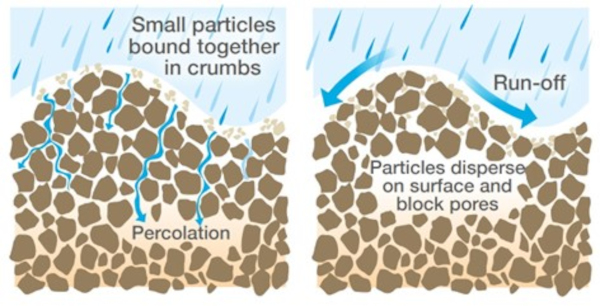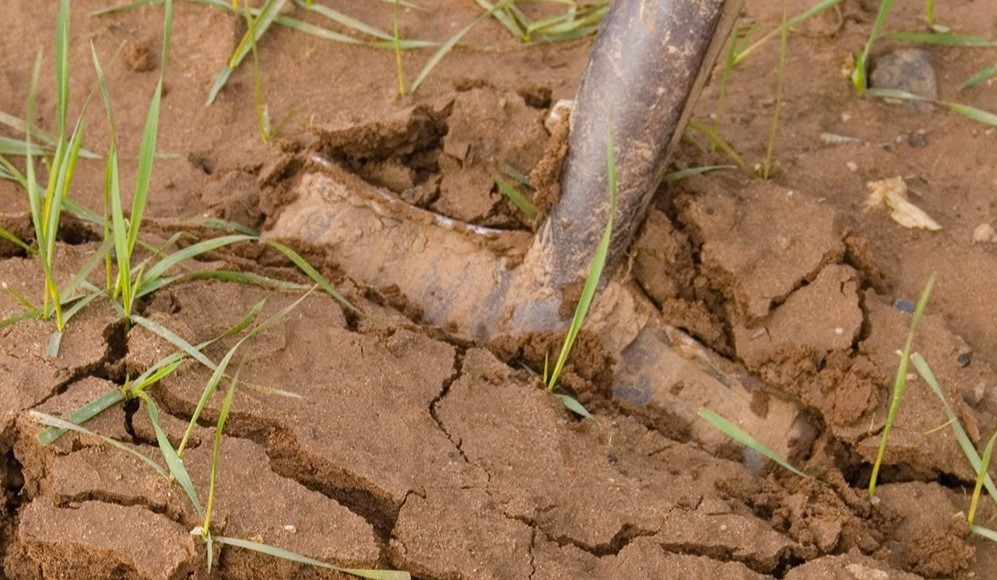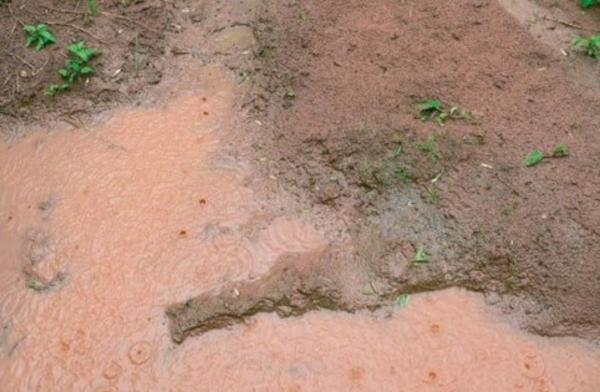- Home
- Knowledge library
- Soil capping and slumping
Soil capping and slumping
Heavy rainfall or irrigation onto bare soil can cause a surface crust (cap); it can also break down soil aggregates below ground, leaving little airspace (slump). Find out about the signs of soil capping and slumping, how to deal with them and how to prevent them from recurring.
Soil capping
Capping occurs when rainfall or irrigation water droplets impact the soil surface. The energy of the droplets causes soil particles to detach and block the coarser surface pores. Once dried, this forms a hard crust.
This hard crust acts as a barrier to water and germinating plants and can lead to crop loss.
It is more common in sandy and silty soils, and where organic matter is low.
Reduced infiltration following soil capping

Symptoms
Symptoms of soil capping include:
- A crust or cap (1–10 mm thick) that can be peeled back from the soil surface with a knife
- Reduced infiltration rate as surface-connected pores become blocked
- Slow or reduced seedling emergence as the crust may act as an impenetrable barrier
- Increased surface water run-off
Visible surface crust as the soil is lifted
 Environment Agency, thinksoils
Environment Agency, thinksoils
Solutions
When faced with a capped soil, first dig some holes to understand the extent of the cap.
While looking at the cap, you should also look at the deeper soil structure. This can easily be done with a spade and our How to assess soil structure (VESS) guide.
Depending on the findings of your assessment:
- If just a surface crust has been found, break up the layer before drilling the following crop
- If further compaction has been found, use targeted cultivations under the right soil conditions

How to prevent soil capping
To prevent soil capping:
- On susceptible soils, avoid seedbed preparation and planting ahead of bad weather
- Use a mulch of crop residues or compost
- For long-term improvement, add organic materials (especially well-composted additions) regularly to improve soil aggregate stability
Soil slumping
Water can cause weakly developed soil aggregates within the soil profile to disperse. This causes the soil to slump as air space is lost and structures are broken down.
Slumping often occurs in the cultivated layer where the most weakly developed soil aggregates are found.
It is more common in sandy and silty soils, where organic matter is low, and in soils with relatively high concentrations of sodium (compared with other cations).
Symptoms
Symptoms of soil slumping can include:
- Loss of soil structure
- A massive hard-set layer with few cracks and greatly reduced pore space
- Poor infiltration
- Low water-holding capacity
- High soil strength
Solutions
To understand the extent and nature of the slump, first dig some holes to look at the soil structure. Then use our simple How to assess soil structure (VESS) guide.
Slumped soils can be improved by:
- Using targeted cultivations under the right soil conditions
- Growing roots through the soil to rebuild and maintain structure
How to prevent soil slump
To prevent soil slump:
- On susceptible soils, check the forecast carefully and avoid seedbed preparation and planting ahead of any bad weather
- Assess soil moisture ahead of any cultivation to make sure that it is not too wet or too dry
- Do not over-cultivate
- On lighter-textured soils, increase soil organic matter, maintain surface cover and reduce soil trafficking
- On soils with high sodium, add lime or gypsum to help improve soil structure
Useful links
Find out about the role of organic matter in soil
Learn more about the soil pore network and water infiltration
Find out how drainage could help
Read our introduction to cover crops
Find out how to easily assess soil moisture content ahead of cultivation
Liming recommendations for arable and grassland soil
See visual case studies of soil capping and slumping in the Environment Agency thinksoils manual

